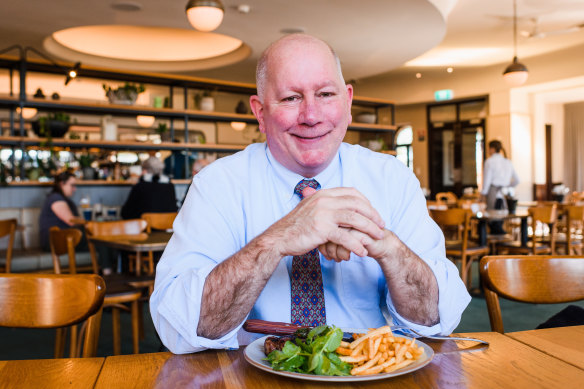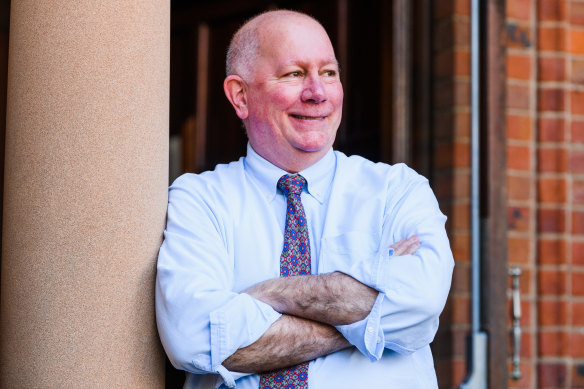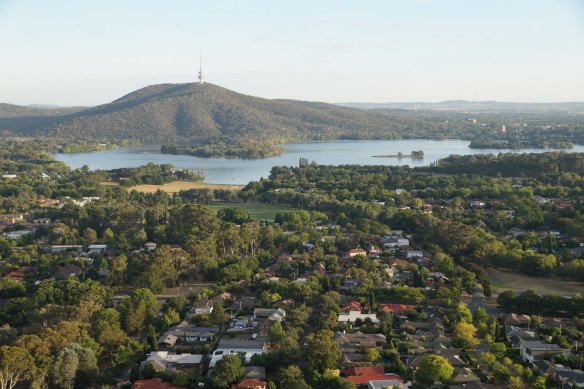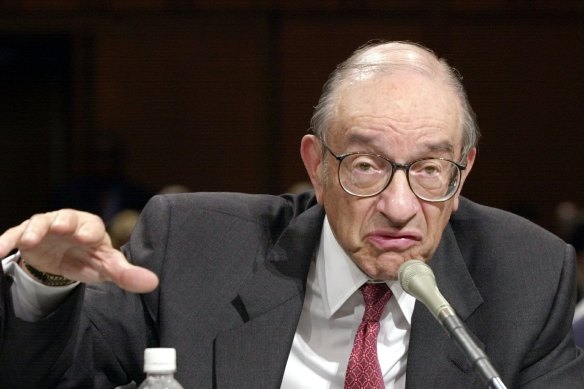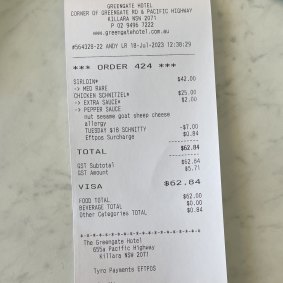
Save articles for later
Add articles to your saved list and come back to them any time.
Property listings
Free-market think tank boffin Dr Peter Tulip reveals over a pub lunch that he and Prime Minister Anthony Albanese were Young Labor members in the late 1980s and rode their bikes to the same economics lectures at the University of Sydney.
“I have always been really interested in politics,” he says. “And I’d always wanted to make a contribution, and economics strikes me as the most powerful way of doing that. Economists run the country.”
Peter Tulip has worked at highest level of central banking.Credit: James Brickwood
“Really?” I ask.
“They certainly did back in the very distant past when I was thinking about careers.”
Since his university days, Tulip has worked as an economist at some of the top banks and organisations in the world, including the OECD, the US Federal Reserve and the RBA.
But he is a walking contradiction. He has spent much of his 37-year-career rubbing shoulders with the upper crust of central banking, and his current role is as the chief economist of the Centre for Independent Studies, which describes itself as committed to classic liberalism. Nevertheless, he has become a somewhat unlikely champion for working-class families.
The pub’s $18 chicken schnitzel special.Credit: Louise Kennerley
“We need to care more about renters and young home buyers and defer less to wealthy homeowners’ fear of change,” he wrote in 2021 in the centre’s submission to the Morrison government’s inquiry into housing affordability.
“Our nurses, policemen, shop assistants are being consigned to the outskirts where there is a two- or three-hour commute to work … There is a huge problem that working-class families can’t afford to live within commuting distance of the city.”
Unless more housing is built, working-class families will not be able to afford their own homes in Australia, Tulip says, declaring planning restrictions that pander to NIMBYism as the cause of the housing crisis in the country.
The 61-year-old Roseville resident is prolific on X, formerly known as Twitter, arguing that the solution to the country’s housing crisis is to add more supply with anyone on the social media site.
Tulip would happily welcome more development into his neighbourhood.Credit: James Brickwood
So would he allow for more housing development in his own backyard, not far from where we meet for lunch at a humble pub, the Greengate Hotel in Killara? It’s on the lower north shore, which is known for its leafy, peaceful neighbourhoods, partly thanks to its residents vehemently opposing density.
His response is emphatic. “Even if I didn’t like having a block of apartments over my back fence,” which, he later clarifies, wouldn’t bother him in the least, “I would like the new shops and restaurants and the new bus service that typically accompany that higher density. And I think NIMBYs forget that; that with the higher density comes a whole lot of urban amenities that people really value.”
We both land on pub classics: Tulip picks a sirloin steak, cooked medium rare, and I pick the $18 chicken schnitzel. He says the Greengate is one of the few pubs to choose from in his area.
Tulip grew up in North Epping and attended Epping Boys High School – familiar to me as I grew up on the shabbier west side of Epping. We agree that not much has changed by way of housing in North Epping, although high-rise apartments have sprung up in other parts of the suburb closer to the train line.
Tulip ordered the sirloin steak, cooked medium rare.Credit: Louise Kennerley
Tulip argues it has retained its beauty, as have similar parts of Sydney, based on an incredibly unequal distribution of wealth and access to homeownership. “All those lovely houses with lovely gardens, a huge amount of them are owned by people with inherited wealth. So while, visually, it might be appealing, the underlying social arrangements are unattractive.”
Later on, Tulip decries heritage protection policy for turning Sydney into a living museum with the price of admission to live in houses in some parts of the city that have more stringent heritage protection, such as the inner west or the eastern suburbs, hitting $3 million to $4 million.
“The wealthy landowners who got there first think that that’s a good deal. But then they’re pulling up the ladder behind them and saying ‘screw you’ to the newcomers. It’s just unfair, and it’s incredibly inefficient.”
I’m curious to know if he has ever lived in an apartment and enjoyed it? Plenty, he says, and been happy. Later he admits: “I mean, if I could live on a farm, a two-minute commute from work, that would be glorious. But clearly that’s unrealistic. If you want a modern, prosperous economy, you need urban density. Putting people closely together is how ideas develop, and how the industries of the future prosper.”
Tulip didn’t think housing in Canberra was a good investment.Credit: AFR
In his formative years, Tulip resisted homeownership. His partner (who is a Herald journalist), bought a property in Canberra, but Tulip wasn’t convinced it was a good investment.
“At that time, I thought housing was a big gamble,” he says. “And you would get bigger returns from putting your money in superannuation … I didn’t see how Canberra could be a good buy when you drive from one suburb in Canberra to another, you’ll drive through sheep paddocks and kangaroos and just empty grassland … I was wrong about Canberra real estate.”
The reason prices rose beyond the expectations of a well credentialled economic specialist? The highly regulated planning system, which restricted supply, a conclusion he drew after looking into the research. It has become a Tulip mantra – his explanation for the housing affordability crisis countrywide; more on that later.
Despite his misgivings, his partner’s Canberra purchase turned out to be a good one as it helped them buy a three-storey house in Bethesda, Maryland, his first home purchase. It’s where they ended up after he was hired at the Federal Reserve in Washington, DC.
The pleasant middle-class suburb was a big contrast to the place they had spent the preceding five years: crime-heavy Philadelphia. He had studied a PhD in economics at Penn State on scholarships. One of his ANU teachers, Adrian Pagan, who went on to become a Reserve Bank of Australia board member, had encouraged him to study abroad.
Former US Federal Reserve boss Alan Greenspan took some heat for decisions towards the end of his tenure.Credit: AP
He speaks fondly of his time at the Federal Reserve. Then-chairman and Reagan appointee Alan Greenspan hired him, and Tulip left shortly before Greenspan came under fire for stoking the dotcom bubble and the subprime mortgage crisis. Tulip’s time at the Fed was a career highlight.
“I routinely felt like I was one of the dumbest people in the room at the Fed,” he says. “My bosses were people like Ben Bernanke and Janet Yellen and Rick Michigan and Larry Meyer. And I could keep going on there. They were people that wrote the textbooks [where] … I learnt about monetary policy when I was an undergraduate. And the RBA has nothing like that intellectual firepower.”
Not only was he surrounded by economic titans, but Tulip says the Federal Reserve also conducted research and made decisions that set the agenda around the globe, such as its inflation targets, unlike the RBA.
After more than a decade of living in America, Tulip and his family still felt Australia was home. They missed the lifestyle and were growing uncomfortable with America’s politics and gun culture.
As a cricket fanatic, he also keenly felt the lack of baggy greens, but it was his twin sons developing US accents that made him draw the line. “As soon as I heard that, I rushed off to the Qantas office.”
The bill.Credit:
They returned to Australia and Philip Lowe hired him as senior research manager for the RBA. But his 12 years at the bank proved frustrating. Having thrived on the rigorous economic research and discussion of the Federal Reserve, he felt the same work was often ignored back home.
In the end, he quit the RBA, detailing his grievances in a resignation letter, which was released by the bank after a journalist made a Freedom of Information request that Tulip opposed.
I observe he must feel somewhat vindicated by the Labor government’s review of the bank, which triggered the appointment of new governor Michelle Bullock and the most comprehensive overhaul of the bank’s operations since its inception. Is she up to the job?
His answer is circumspect: “A lot of people will be suspicious that an insider, who has thrived under the old regime, will be enthusiastic about changing the culture. But [Treasurer] Jim Chalmers clearly thought about that a lot. And has reassured himself that she’s willing and capable.”
So, why did he join the Labor Party all those years ago? Tulip can’t precisely place when he joined, but guesses it was about the last year of high school, and says it was because he believed in the party’s vision for Australia’s future.
“Back in the 1980s, Bob Hawke and Paul Keating seemed like the voice of social reform and progress, and a sense that society can be better. And a lot of what they did was, I might crudely describe, as the [Centre for Independent Studies] agenda,” he says.
“There was a lot of deregulation, to disempower the wealthy and the privileged, who were maintaining this captured economy and, so, partly there was the sense of tying in with why I was studying economics.”
Still, I find it hard to reconcile his membership in the Labor Party and his affordable housing advocacy for workers with his career pivot to the centre-right Centre for Independent Studies. But he maintains the two share similar tenets.
“I don’t see the CIS as centre right. The CIS supports free markets and limited government. As do I. I don’t see that as a right-wing policy. I see myself as an economist first. I don’t see myself as an ideologue or a zealot. But the best prospects for economic reform, or even more broadly, social policy reform, I think, are a marriage of freer markets with a progressive distribution of income.”
I counter that the free market has not solved the housing crisis. How does he explain that failure?
“It’s not a free market because the planning system decides how much housing we can have … I think it is insane for people to say that the free market has caused our housing problems,” he says. “The housing market is one of the most regulated, restricted markets we have.”
He characterises his commitment to the Labor Party today as “weak”.
We’ve long finished our lunch, but I get the sense he could talk for another two hours about policy. So, we opt for coffees. I ask whether he thinks his twin sons will ever be able to buy a home in Sydney?
“Probably waiting for mum and dad to die,” he says.
Cut through the noise of federal politics with news, views and expert analysis. Subscribers can sign up to our weekly Inside Politics newsletter here.
Most Viewed in Property
Source: Read Full Article
